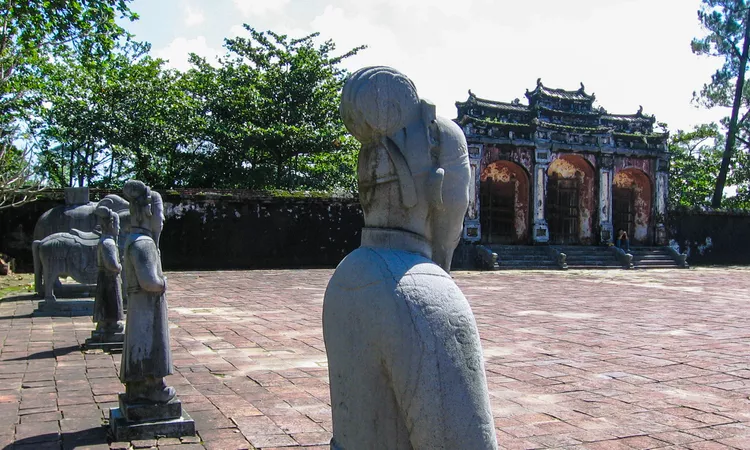Summary
In Vietnam, Serene Harmony Marks a Revered Emperor’s Final Rest

The Minh Mang Royal Tomb located in Hue, Vietnam, serves as the final resting place for one of the Nguyen Dynasty’s most dedicated Confucians, whose reign epitomizes the pinnacle of Nguyen authority throughout the nation.
Compared to other royal tombs in Hue, this tomb exhibits a balanced design between the layouts of Tu Duc’s and Khai Dinh’s. While it lacks the expansive dimensions of the former, it offers a refinement surpassing the latter. The Minh Mang tomb, therefore, provides an unparalleled fusion of landscaping and architecture among the royal tombs in Hue.
Each structure and hillock within the tomb harmonize with its overall composition. If the tomb speaks on behalf of the Emperor interred within, it conveys the image of a ruler who sought equilibrium during his reign, governing his subjects with a just yet firm authority while resisting foreign influences (notably, Minh Mang was chosen for his resistance to Christian missionary work, among other factors).
The Buildings Within Minh Mang Royal Tomb

Emperor Minh Mang ruled from 1820 until 1840. The construction of his mausoleum initiated in the first year of his reign but remained unfinished at the time of his death. It fell upon his son and successor, Thieu Tri, to see the completion of his final resting place, enlisting the aid of approximately ten thousand laborers and artisans.
Approximately 40 monuments are part of Minh Mang’s royal tomb, all set on a 44-acre oval plot encircled by a high wall. The complex is divided by a central pathway approximately 2,300 feet long along which the monuments are positioned. In contrast, Tu Duc’s Tomb displays a layout in two axes—one for the palace and living quarters, and another for the necropolis.
This configuration is bordered by reflective ponds lined with pine trees.
Entering Through Dai Hong Mon

Vehicles approaching Minh Mang’s Royal Tomb must halt at a designated parking area/rest stop at the entrance, necessitating a walk of approximately 500 yards along a dirt path to arrive at the initial point: Dai Hong Mon Gate.
Dai Hong Mon features three openings; the central gate was opened a single time to allow the entrance of the Emperor’s body. After the burial of the Emperor, the gate was permanently closed. Visitors are required to enter through the two lateral gates, which were designated for mandarin officials and other members of the royal family.
This architectural feature of three gates is typical in structures associated with emperors; the central gate is reserved exclusively for the Emperor while other individuals must utilize the side gates. Visitors to the Hue Citadel, the other royal tombs in Hue, and the Temple of Literature in the capital city of Hanoi will observe this arrangement firsthand.
Forecourt and Stele Pavilion

Dai Hong Mon marks the easternmost point of a linear axis that aligns the structures within the Minh Mang Tomb. Following Dai Hong Mon, visitors encounter the forecourt, or Honor Courtyard, characterized by its traditional double rows of mandarins, elephants, and horses.
From the forecourt, guests can ascend one of three granite staircases leading up to the square Stele Pavilion, or Bi Dinh. In proximity, though now absent, stood a sacrificial altar for livestock, which was offered for the sake of the Emperor’s spirit.
The Stele Pavilion houses the Thanh Duc Than Cong stele, which is inscribed with a biographical account of the Emperor, composed by his successor, Thieu Tri.
Salutation Court

Beyond a series of courtyards following the Stele Pavilion, visitors encounter Hien Duc Gate, which regulates access to Sung An Temple, where the memories of the Emperor and his Empress Ta Thien Nhan are honored. Sung An’s courtyards are accompanied by Left and Right Temples in the front and Left and Right Rooms situated behind.
From Sung An, three bridges extending over the Lake of Impeccable Clarity (Trung Minh Ho) and an additional gate (Hoang Trach Mon) lead to the Bright Pavilion (Minh Lau), a square two-story pavilion with eight roofs. Two obelisks flank the Minh Lau Pavilion, symbolizing the Emperor’s might.
The Pavilion is elevated upon three terraces, each representing a power in the universe: Earth, water, and heaven itself. Two flower gardens positioned behind Minh Lau form a design resembling the Chinese character denoting longevity.
A further stone bridge crosses the crescent-shaped Lake of the New Moon (Tan Nguyet), leading to an expansive staircase adorned with sinuous dragon handrails. This staircase ascends to a circular wall encircling the burial site. A secured bronze door restricts entry to the Emperor’s final resting place: an artificial hill filled with pines and shrubs.
Transportation and Other Information

- Accessing Minh Mang’s tomb: The location is situated seven miles from Hue and is accessible via package tours, xe om, and cyclo drivers operating from the town center.
- Essentials: Umbrella, sunglasses, and a water bottle during the sunny season (April-September), as well as an umbrella and raincoat during the rainy months (October-March). Comfortable footwear is advised due to substantial walking distances.





